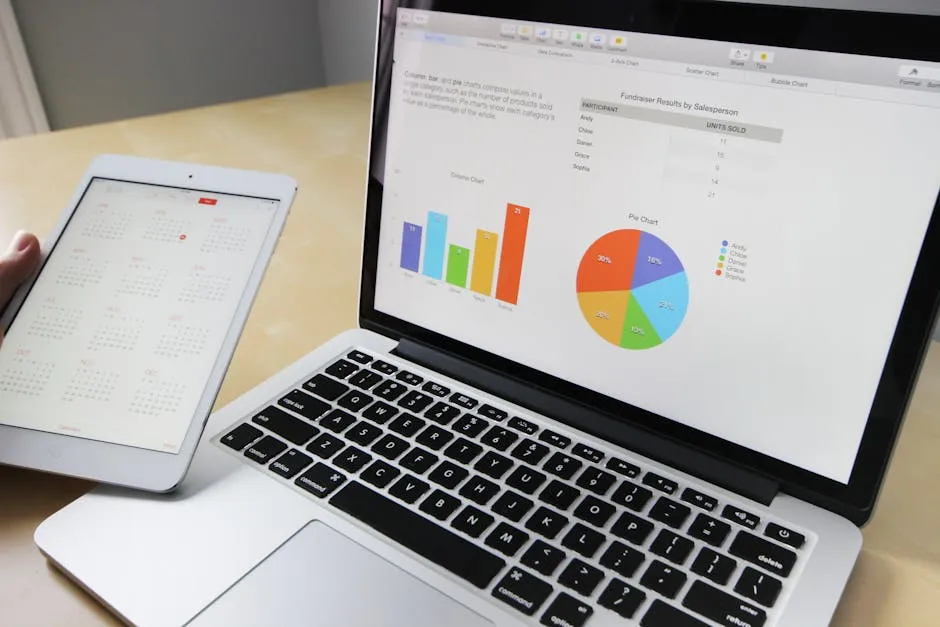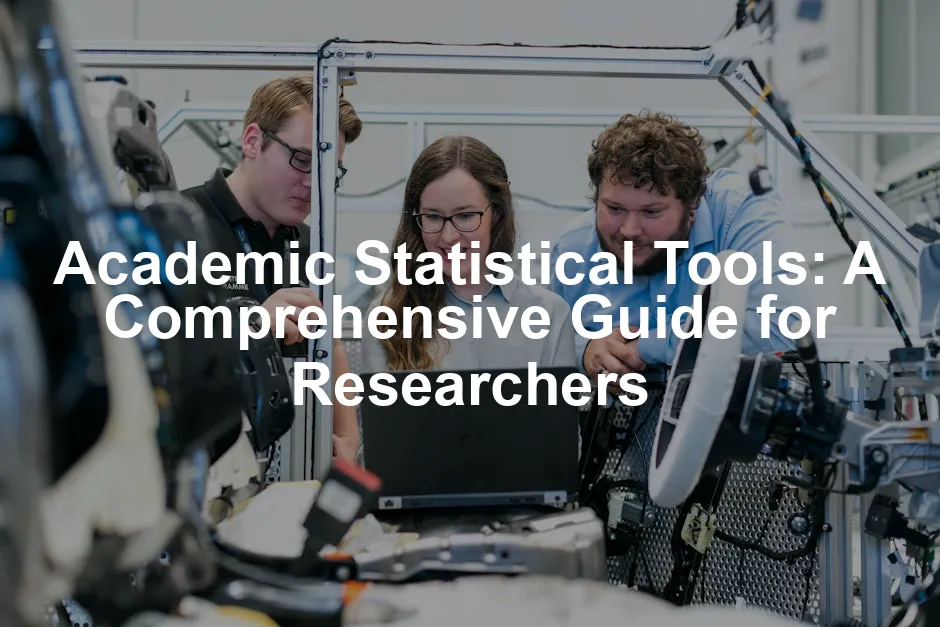Introduction
Statistical tools are essential in academic research. They aid in data analysis, guiding decision-making and ensuring research integrity. Understanding these tools enhances the quality of studies, leading to reliable conclusions. As a researcher, being familiar with various statistical tools can significantly improve your work.
Summary and Overview
Academic statistical tools encompass various methods and software crucial for data analysis in multiple fields, including social sciences, health, and economics. These tools help researchers visualize and interpret data accurately. Common types include software packages like SPSS, R, and Excel, as well as statistical methods such as hypothesis testing and regression analysis. Selecting the right tool is vital for precise data interpretation and can impact research outcomes. This article will cover the definition of statistical tools, the differences between descriptive and inferential statistics, and the importance of statistical literacy. We will also explore various statistical software options and methods that can enhance your research.

Understanding Academic Statistical Tools
Academic statistical tools are methods and software used to analyze data in research. Their primary purpose is to help researchers draw meaningful conclusions from numerical data. Understanding these tools is crucial for effective research.
Descriptive statistics summarize data, offering insights into central tendencies and variability. Common measures include the mean, median, and mode. In contrast, inferential statistics make predictions about a population based on sample data. This includes hypothesis testing and confidence intervals.
Statistical literacy is essential for researchers. It empowers them to choose appropriate methods, interpret results accurately, and communicate findings effectively. Surprisingly, many researchers misuse statistical tools, which can lead to incorrect conclusions. A study found that nearly 30% of researchers misapply statistical techniques, highlighting the importance of education in this area.
As a researcher, consider evaluating your knowledge of statistical methods. Are you confident in your ability to choose the right tools for your studies? Engaging with these concepts can greatly enhance your research capabilities. For a comprehensive introduction to the subject, check out Statistics for Dummies. It’s a great way to brush up on your statistical knowledge!

Types of Statistical Tools
Software Tools
Statistical software packages are essential for academic research. They simplify data analysis and enhance the quality of findings. Let’s take a look at some popular software tools used in academia.

SPSS
SPSS, or Statistical Package for the Social Sciences, is widely used. It features a user-friendly interface, making it accessible. Researchers can conduct various statistical analyses, including regression and ANOVA. SPSS is prevalent in social sciences, health sciences, and marketing. For more on troubleshooting SPSS, check out this comprehensive guide.
Understanding SPSS is crucial for conducting various statistical analyses effectively. Learn more about SPSS troubleshooting and solutions here.

R
R is an open-source programming language favored by statisticians. Its flexibility and extensive libraries make it powerful for data analysis. R supports complex statistical operations and data visualization. Many researchers appreciate its ability to customize analyses and create tailored visual outputs. You can find a detailed AP Statistics formula sheet that can help you with your R analyses.
R’s flexibility makes it a popular choice for statisticians, especially for custom analyses. Discover the AP Statistics formula sheet for more insights.

SAS
SAS, or Statistical Analysis System, is a comprehensive software package. It excels in advanced statistical analysis and data management. SAS is commonly used in healthcare and business sectors for its robust analytics capabilities. Despite a steep learning curve, its extensive functionalities are worth the effort. For an in-depth analysis of crime statistics using SAS, refer to this article on Arkansas crime statistics.
SAS is a powerful tool for advanced statistical analysis and data management. Explore the in-depth analysis of Arkansas crime statistics using SAS.

Stata
Stata is a versatile tool for data analysis, particularly in economics and social sciences. It combines a command-line interface with graphical options. Stata is known for its speed and efficiency in handling large datasets. Researchers often use it for comprehensive data manipulation and statistical modeling.

Overview of Software Tools and Their Applications
Each statistical software has unique strengths and applications. SPSS is user-friendly, ideal for beginners. R offers flexibility and extensive libraries for advanced users. SAS is robust, suitable for large datasets, while Stata is efficient for social science research. Understanding these tools will enhance your ability to conduct effective research.

Comparison of User-Friendliness and Functions
When comparing user-friendliness, SPSS ranks high due to its intuitive interface. R and SAS require more technical expertise. Stata strikes a balance, offering both graphical and command-line options.
Survey Results on Software Preferences
According to recent surveys, SPSS remains a top choice among researchers. R’s popularity is rising, especially among data scientists. SAS and Stata have loyal user bases, particularly in specific industries. Understanding these preferences can help you choose the right tool for your research needs. If you’re looking for a deep dive into data science concepts, consider picking up Data Science for Business. It’s a fantastic resource!

Advanced Statistical Methods
Inferential Statistics
When researchers want to make predictions about a larger group based on a smaller sample, they use inferential statistics. This approach includes several key methods: hypothesis testing, confidence intervals, and regression analysis. Each of these plays a vital role in drawing conclusions from data.

Hypothesis Testing
Hypothesis testing is foundational in inferential statistics. It begins with two competing statements: the null hypothesis (H0) and the alternative hypothesis (H1). The null hypothesis suggests no effect or no difference, while the alternative proposes that an effect exists. Researchers use statistical tests to determine if there is enough evidence to reject the null hypothesis. This process often involves calculating a p-value, which indicates the probability of observing the data if the null hypothesis is true. For a comprehensive guide on hypothesis testing, refer to this cheat sheet. Additionally, if you’re new to this topic, consider reading Hypothesis Testing for Beginners. It’s perfect for grasping the basics!
Hypothesis testing is a critical aspect of inferential statistics. Check out this comprehensive cheat sheet for more insights.

Confidence Intervals
Confidence intervals (CIs) provide a range of values that likely contain the population parameter. They help researchers understand the precision of their estimates. A 95% confidence interval means that if the same study were repeated multiple times, 95% of the intervals would capture the true parameter. This method is crucial for assessing the reliability of statistical estimates and gives insight into the uncertainty surrounding them.

Regression Analysis
Regression analysis is a powerful tool for examining relationships between variables. It helps answer questions like, “How does variable X affect variable Y?” There are various types of regression, including linear and logistic regression. Linear regression predicts a continuous outcome, while logistic regression is used for binary outcomes. For instance, researchers might use regression to predict exam scores based on study hours. Studies show that regression analysis can accurately predict outcomes, with some models achieving over 80% accuracy. For a deeper understanding of regression analysis, refer to this comprehensive guide. If you’re keen to learn more about the theory behind regression, consider grabbing Regression Analysis: A Comprehensive Guide. It’s an excellent resource!
Regression analysis is essential for understanding variable relationships. Explore this comprehensive guide to regression analysis.

Key Topics
Each of these methods plays a significant role in validating research findings. Hypothesis testing ensures conclusions are backed by evidence. Confidence intervals provide context about the data’s reliability. Regression analysis offers insights into relationships between variables, enhancing the depth of analysis.
Relevant Statistics/Data
Research has shown that regression models can predict outcomes with remarkable accuracy. For example, a study found that models using regression analysis could predict exam scores with a 90% accuracy rate when appropriate variables were included. This highlights the importance of careful variable selection in research.

Call to Action
Want to sharpen your skills? Practice hypothesis testing using sample datasets available online. This hands-on experience will enhance your understanding of inferential statistics and boost your research capabilities. And if you’re looking for practical insights into data visualization, consider Data Visualization: A Practical Introduction. It’s a must-read for anyone serious about presenting data effectively!

Choosing the Right Statistical Tool
Factors to Consider
Choosing the right statistical tool is essential for successful research. Several factors should guide your decision.
- Research Goals: Clearly define what you aim to achieve. Are you testing a hypothesis, analyzing relationships, or simply summarizing data? Your goals will help narrow down the tools that fit your needs.
- Data Type: Consider the nature of your data. Is it categorical, continuous, or ordinal? Certain statistical methods work better with specific data types, so understanding your data is crucial.
- User Skill Level: Assess your comfort with statistical concepts and software. Some tools, like R and SAS, require more advanced knowledge, while others, like SPSS and Excel, are beginner-friendly. Choose a tool that matches your skill level to ensure effective use.

Key Topics
Each of these factors influences your choice of statistical tools. Making informed decisions based on your research goals, data type, and skill level leads to more accurate analyses. If you’re looking to delve deeper into various statistical methods, The Art of Statistics: Learning from Data is a fantastic resource!
Relevant Statistics/Data
Research shows that selecting appropriate tools significantly impacts research outcomes. A study indicated that researchers using suitable statistical methods increased the validity of their findings by over 30%.
Call to Action
Evaluate your current research projects. Consider whether your chosen tools align with your goals and data types. This reflection can lead to more accurate and reliable results in your future studies. And if you want to expand your knowledge, don’t miss out on The Data Warehouse Toolkit. It’s a valuable addition to your library!
Conclusion
Selecting the right academic statistical tools enhances research quality. Understanding these tools improves data analysis and research outcomes. Continuous learning and adapting to new statistical methods and software are essential for success in your research journey. Embrace this opportunity to elevate your statistical skills and explore new possibilities in your studies. For further reading, consider The Elements of Statistical Learning. It’s a must-read for anyone serious about statistics!
FAQs
What is the difference between parametric and non-parametric tests?
Parametric tests assume that the data follows a specific distribution, usually a normal distribution. They require certain conditions, like homogeneity of variance and interval data. Common examples include the t-test and ANOVA. These tests are powerful and provide reliable results when data meets the assumptions. On the other hand, non-parametric tests do not rely on any specific distribution. They are ideal for ordinal or nominal data and can be used when the assumptions for parametric tests are not met. Examples include the Mann-Whitney U test and the Kruskal-Wallis test. Non-parametric tests are less powerful but more flexible, making them suitable for a wider range of data types.
How do I choose the right statistical test for my data?
Choosing the right statistical test is crucial for accurate analysis. Start by defining your research goals. What do you want to find out? Are you comparing groups, testing relationships, or estimating parameters? Next, consider your data type. Is it categorical, ordinal, or continuous? For categorical data, chi-square tests may be appropriate. If your data is continuous, consider t-tests or ANOVA for comparisons. Lastly, evaluate your sample size and distribution. If your sample is small or not normally distributed, non-parametric tests might be more suitable. Always ensure your choice aligns with your research objectives and data characteristics to enhance the validity of your analysis.
Please let us know what you think about our content by leaving a comment down below!
Thank you for reading till here 🙂
All images from Pexels




